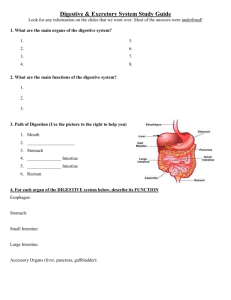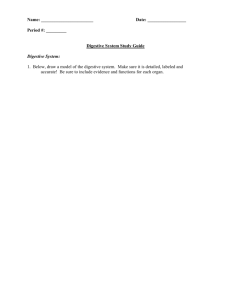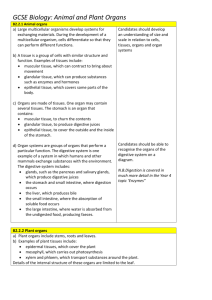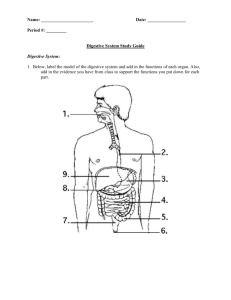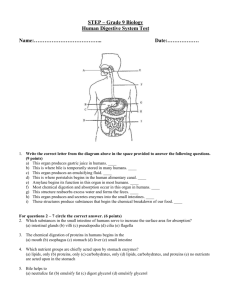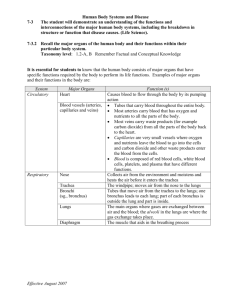3.2 Organs and Systems
advertisement
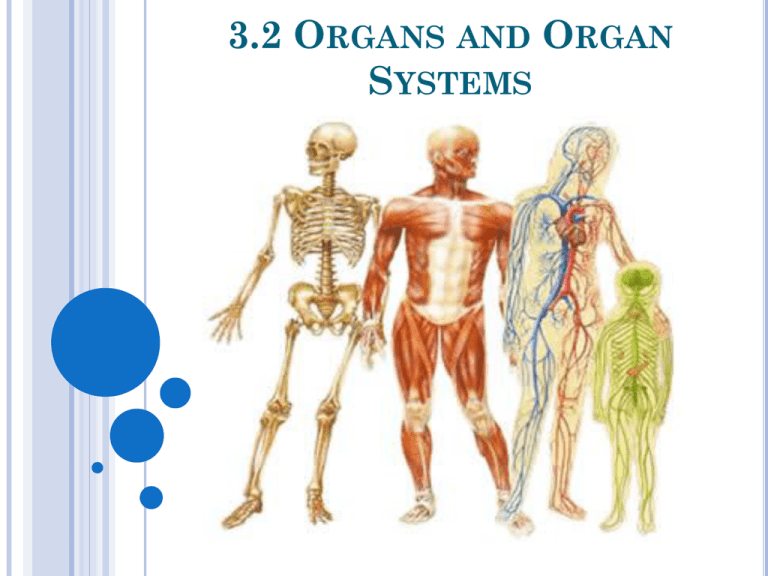
3.2 ORGANS AND ORGAN SYSTEMS HOOK (VIDEO) AGENDA Hook Video on Bicycle Riding From Cells to Tissues to Organs Types The of Organ systems Digestive Organ System NOTE: TUESDAY QUIZ ON THE DIGESTIVE SYSTEM FROM CELLS TO TISSUES AND ORGANS Human stem cells differentiate into epithelial, muscle, nervous, and connective cells. These accumulate to become tissues. These tissues are organized to form organs, which are designed to perform a specific function. The organs are used to form organ systems which together provide everything necessary to keep the organism (human) alive. HIERARCHY OF ANIMAL SYSTEMS Organ Systems (Circulatory, Digestive, Respiratory, etc.) Organs (Heart, Liver, Intestine, Blood Vessel, etc.) Tissues (Connective, Muscular, etc.) Specialized Cells (Blood, Heart, Bone, etc) Stem Cells T-P-S: NAME THE ORGAN SYSTEMS ORGAN SYSTEMS IDENTIFIED A. B. C. D. E. F. G. H. I. J. K. Muscular Skeletal Nervous System Endocrine Circulatory Integumentary Lymphatic (Immune) Respiratory Digestive Excretory Reproductive DIGESTIVE SYSTEM The digestive system has 4 primary functions: Ingestion Digestion Absorption Egestion INGESTION & EGESTION Ingestion refers to the consumption of a substance (1st step). Egestion refers to the removal of unwanted materials from the body. (Last step) DIGESTION Digestion is the mechanical and chemical breakdown of food into smaller components. (2nd step) It is the breakdown of large food molecules into smaller ones. ABSORPTION (FIG. 3.16) Absorption is the process by which digested food nutrients and water are taken from the intestine and moved throughout the body. (3rd step) Body (Through Blood Vessels) Body (Through Blood Vessels) DIGESTIVE SYSTEM LABELLED Gallbladder Pancreas IN CLASS WORK/HOMEWORK Newspaper article (Due Monday) Read pages 85-92. Read pages 93-99 for the quiz on Tuesday November 15 Answer Questions 1,3, 4 (page 90) Answer questions #4-8 (page 92) Answer questions #1-3 (page 99) Read ahead to the circulatory system (pages 100102) HOOK VIDEO LABEL THE DIGESTIVE SYSTEM COMPONENTS SCENARIO: EATING A BURGER The burger enters the oral cavity (i.e. the mouth) A bite is taken out of the burger and chewing proceeds (mechanical digestion) The salivary glands secrete amylase to breakdown the carbohydrates. (chemical digestion) Once the food has been broken down into small enough pieces, the food is swallowed. DOWN THE OESOPHAGUS TO THE STOMACH The partly digested food travels through the pharynx down the oesophagus through peristaltic contractions. DIGESTION IN THE STOMACH The food passes through a sphincter into the stomach where gastric juices surround the food. Hydrochloric acid and the enzyme pepsin break down most of the protein. (chemical digestion) The stomach then covers the food in mucus and sends the food down to the small intestine (duodenum) THE SMALL INTESTINE The pancreas, liver, and gall bladder release chemicals to help break down the food further. The small intestine contains millions of tiny folds called villi and microvilli Provides increased area for absorption Nutrients and water can be reabsorbed into the bloodstream THE LARGE INTESTINE Includes the colon, rectum, and anus Mainly absorbs water Also absorbs vitamins and various salts Undigested food leaves as feces (E.g. Corn) VIDEO/MULTIMEDIA TOOL http://kitses.com/animation/swfs/digestion.swf REVIEW SNOWBALL ACTIVITY (QUESTIONS) Take out a blank sheet of paper Skim through pages 9799 in the textbook. Create questions to review The Digestive System Begin the snowball activity BREAK TIME (5-10 MIN) EXAMINING HUMAN ORGANS AND SYSTEMS Old Method Exploratory surgery New Methods Medical imaging technologies X-ray CT or CAT scan Ultrasound MRI Scan X-RAY Transmits electromagnetic waves that radiate through the body. Since bone is dense, the radiation is absorbed. Produces an image of bone structure CT OR CAT SCAN Makes use of X-rays to get thin slices of a body part. Each slice is computerized and joined to form a 3D image ULTRASOUND Makes use of high frequency sound waves. Waves are directed at a body part for a period of time in order to examine movement MRI Magnetic Resonance Imaging Uses radio signals in a magnetic field to create images of body parts IN CLASS WORK/ HOMEWORK Read/Review The Digestive System (pages 96-99) for the quiz on Tuesday November 15 Read ahead to the circulatory system (pages 100-102)


